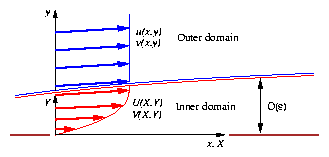
| (1) | ||||||||||||||||||||||||||
|
| device | Re | e |
| model airplane | 1 ×104-5 ×105 | 0.01 - 0.0015 |
| light aircraft | 1 ×106-5 ×106 | 0.001 - 0.0005 |
| heavy aircraft | 5 ×106-5 ×107 | 0.0005 - 0.00015 |
|
| (2) | ||||||||||||||
The equations of the outer flow are the same as (1), except that the wall boundary condition is replaced by a matching condition with the inner flow.
| (3) | ||||||||||||||||||||||||
| (4) | |||||||||||||||||||||||||||||||||||||||||||||||||||||||||||||||||||
| (5) | ||||||||||||||||||||||||
| (6) | ||||||||||||||||||||||||
The zeroth-order equations for the inner domain are
| (7) | |||||||||||||||||||||||||||||||||||||||||||
|
The overall zeroth-order equation system (6) and (7) constitutes the Classical Boundary Layer Theory problem. It has the following features:
The inner domain equations correspond to the classical Thin Shear Layer Equations. They can be further transformed to eliminate singularities at leading edges, such as the Local Scaling Transformation, or its subset the Falkner-Skan Transformation.
There is a one-way coupling from the outer to the inner equations: The outer equations can be solved first independently, and the resulting velocity u then provides the boundary condition and pressure-gradient term for the inner equations, as shown in Figure 2.
| (8) | ||||||||||||||||||||||||
The first-order equations for the inner domain are
| (9) | |||||||||||||||||||||||||||||||||||||||||||
The overall first-order equation system (8) and (9) constitutes the Intaractive Boundary Layer Theory problem. It has the following features:
The inner domain equations still correspond to the classical Thin Shear Layer Equations, and are treatable with the usual transformation methods.
There is now a two-way coupling between the outer and the inner equations, making all equations one fully-coupled system as shown in Figure 2.